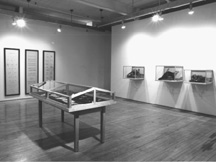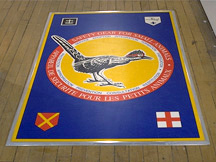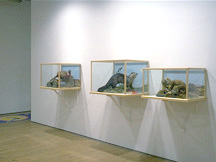- MAIN INDEX | ARTIST INDEX
| November 9 - December 23, 1995 Bill Burns
| |
 Bill Burns, installation view of "Safety Gear for Wild Animals", 1995. Photo Peter MacCallum. 18K | |
 Bill Burns, installation detail, 1995. Photo Peter MacCallum. 18K |  Bill Burns, installation detail, "Dioramas - Safety Gear on Pheasant, Safety Gear on Otter, Safety Gear on Ferret", 1995. Photo Peter MacCallum. 18K |
| Media Release Mercer Union is pleased to present The Museum of Safety Gear For Wild Animals, by Canadian artist Bill Burns. Burns' previous installation Analgesia (1993), exhibited at Galerie Rochefort in Montreal, employed architectural dioramas on the theme of the pharmaceutical industry. The Museum of Safety Gear For Wild Animals consists of dioramas with taxidermied animals wearing safety gear, drawings, and various didactic displays about the needs of animals. The installation poses the question: what kind of gear do animals need to protect themselves from the hazards of life in a late capitalist economy? The installation fulfils the goals of natural history museums: to entertain and to form the general public's view of how others live, and become the cultural property of the viewers. The Museum of Safety Gear For Wild Animals alerts us to the dangers of imposing human characteristics on animals as well as the dangers of global environmental degradation. Bill Burns recently moved from Montreal to New York. His work has been exhibited throughout Canada, in New York and several European cities. His past solo exhibitions have been presented at 303 Gallery in New York, Articule Gallery in Montreal and Project K18 in Kassel, West Germany. The Museum of Safety Gear For Wild Animals will be his first Toronto exhibition. Brochure Text: Safety Gear for Wild Animals What's in a resemblance? What is at work--or at play--in the resemblances between humans and animals? Bill Burns has been known to place things associated with humans where they don't normally belong. And here you see a number of lurid and spectacular examples: a respirator on the mouth of an otter, safety goggles on a pheasant, knee pads on a giraffe. In each case the indelible visual force, the shock of these images hinges on the presence and absence of certain resemblances. Or uncertain resemblances. For millennia now, human beings have been intrigued and unnerved by the similarities, real or imagined, between them and animals. In the Middle Ages, the ape was sometimes termed the worst of animals (turpissima bestia), not, it seems, because it was objectively so horrible but because the marked similarity between humans and apes proved too close for comfort. A Victorian populariser of science remarked that turning our attention to the forms and actions of mammalia could "excite unpleasant comparisons." Only one difference, now, is that Bill Burns puts a measure of pleasure back into recognising similarities that might otherwise get under our skin. Resemblance is not identity. And in the realm of resemblance one can emphasise the distance or lack of it between whatever is being compared; one can foreground the points of similarity or all the differences obliterated to register those resemblances. When Dian Fossey becomes a companion for gorillas and Jane Goodall extended family for some chimpanzees, does it prove the possibility or the immense difficulty of the crossover between humans and animals? The exception or the rule? There has been no end of attempts to define the difference between humans and animals. "Man," we are assured, has: Reason (Plato) Politics (Aristotle) Language (Chomsky) Power of Abstraction (Locke) Private Property (Luther) Nietzsche could grant animals any number of things deprived them by other thinkers but denied them the capacity to make and break promises. Which is to say: animals are not ethical beings. For Nietzsche, animals are beyond good and evil in a very elementary way. But the anxious search for differences can mask the fact--if it is one--that the underlying sense is one of resemblance. If the narcissistic insistence on difference is overriding, that does not prevent humans from being relentlessly anthropocentric, ascribing human traits to animals when they may not possess anything of the sort. (Setting up the resemblance in one direction, however, establishes a circuit of possibilities that includes the reverse. Resemblance is not a one-way street). And so it is that we now often ascribe rights to animals, making of them ethical beings, but of a curious sort. We give them the voices they do not have in order for them to then claim their rights. (Or do they have voices in the first place? Wittgenstein claimed that if lions could talk, we wouldn't be able to understand them.) To judge from these works, the cute faces of baby seals are not the driving force behind Bill Burns' art. Should baby seals have rights that toads do not? The once holy trinity of the beautiful, the true, and the good has lost its already shabby aura. If these works are beautiful to look at, they altogether resist fetishizing beauty. This is art not given over to aestheticism. In giving these taxidermed animals a posthumous after-life, Burns points to the perilous existence all animals have in environments dominated by human beings, the endangering species. The reason to devise safety gear is that no one is safe. No animal, no human, no human animal. If there is a politics of animal rights (and human responsibility) here, it is oblique and the furthest thing from dogmatic. A gently corrosive irony pervades Burns' provocations. "Irony" derives from the word "to make small." But aren't Bill Burns' animals already small enough? What exactly is getting smaller because of this irony?
The irony is not just a matter of the wit or humour everywhere in evidence, not just a new way of thinking about pheasant under glass. These works with small animals always reveal a bigger picture, even if it lies outside the frame. That big picture--literalised most graphically as the image of the globe--looms beyond the characters in Burns' bestiary, exceeding anyone's vision. In blurring the lines between animal and human, Bill Burns' sharp focus puts everything in perspective.
| |